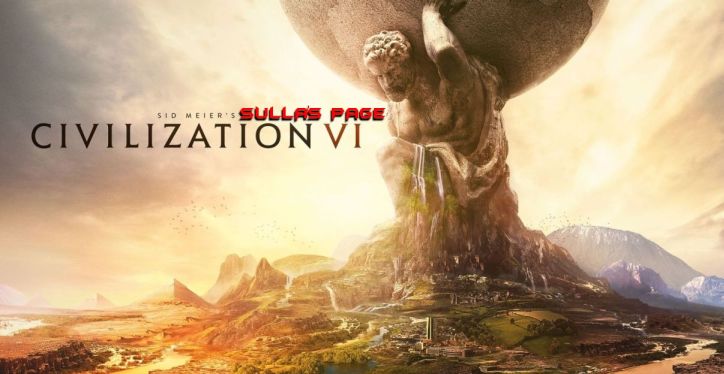
Click here to view with black text on white background


Mvemba of the Kongo
Tiny map, Pangaea, 3 AI Opponents
King difficulty
First Patch (1.0.0.38)
I decided to take on one of the most famous variants in the Civilization series: the One City Challenge (OCC) game. As the name suggests, under these rules the player founds a single city and never builds or acquires any others for the rest of the game. There's a long history of playing OCC games in the Civilization community dating back to the first game, and their difficulty has varied depending on the installment in question. Civ3 was all about large spawling empires, and the OCC game would seem to have been a real challenge, except that the 20k single-city cultural victory could often provide an alternative path to success. Civ4 allowed OCC games to stack unlimited national wonders in the single city, which could almost make the setup easy to play sometimes. Civ4 was arguably the most OCC-friendly game in the series. Civ5 also made things a bit easier than one might expect, since small empires of 3-5 cities were generally the rule in Civ5, and the capital could easily build the national wonders, although a lack of trade routes and limited specialists slots could make the later stages of the game tricky.
The new gameplay in Civ6 has not been kind to the OCC variant. For starters, Civ6 is back to being a game of expansion again; there is no corruption or maintenance costs to work around, and more land is almost always good to have. Limiting your empire to a single city is once again a major restriction. More importantly though, a single city is highly limited in what it can build by the total number of tiles available. Every district eats up a tile, preventing a tile improvement from occupying that location, and wonders tie up tiles even further. The capital in a OCC game will have the full three-ring radius of 37 tiles to work with, but even that will fill up quickly. It will go faster still if there are any mountains or deserts or ice tiles that otherwise can't be built upon. Winning a OCC game in Civ6 requires a lot of planning ahead of time to ensure that the right buildings go on the right tiles.
I decided that I would pursue a Cultural victory in this game, and the best civ choice for that seemed to be the Kongo. Although Mvemba cannot found his own religion, he gets 5 slots in the Palace to hold various Great Works (as opposed to the usual 1 slot) along with additional food/production/gold from relics, sculptures, and artifacts. The biggest problem for a OCC cultural game is lacking places to put all the Great Works, and Mvemba had an answer for that. The Kongo's unique ability provides double Great Writer/Artist/Musician points as well, which is another great choice for a cultural game. The Mbanza unique district also seemed like a perfect fit to solve problems with the housing cap, and having a resourceless unique unit also seemed like a good choice for a civ that almost certainly wouldn't have iron available. The Kongo is essentially the only civ in Civ6 that can truly go "Tall" in the earlier stages of the game, making them an excellent fit for this setup.
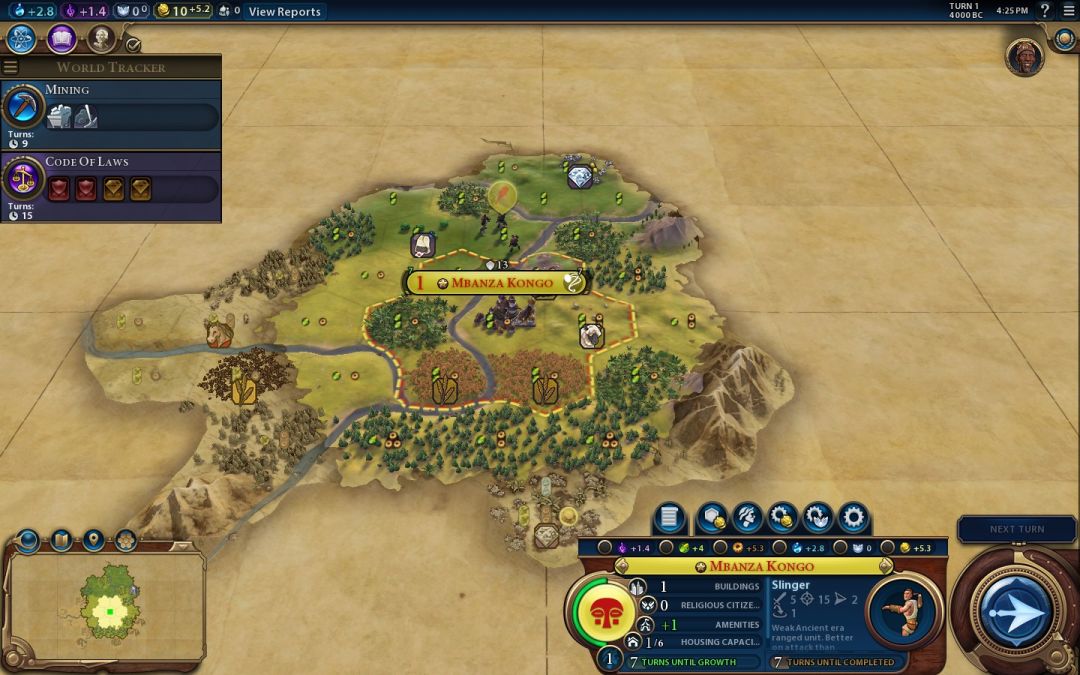
I also chose map settings that would make this game a bit easier to play out. I dropped the difficulty down to Monarch for starters, and chose to play on a Tiny map rather than a Small or Standard one. Tourism in Civ6 is measured on a per-civ basis, and since trade routes are one of the things that boosts tourism output, having fewer enemy civs as opponents makes the game a bit easier (since a OCC setup will have strictly limited trade routes available). I similarly picked the Pangaea setting so that I would meet the other civs quickly, and could start amassing tourism right away without having to wait until the age of interoceanic exploration. Odds were that I would be landlocked and have no chance to build any ships. Finally, I also chose the "Legendary" start option, which would grant me an excellent capital... at the expense of giving everyone else excellent capitals as well. Of course, I could make better use of that than the AI civs.
I settled on the opening turn in a verdant river valley. This seemed like an ideal place to start my game: double wheat tiles with a triple wheat close by, a hill sheep resource, two luxuries present in tea and diamonds, plus horses off to the west. There was also clearly a natural wonder of some kind to the immediate south, where that diamond resource in the fog had an insane yield of 2 food / 2 production / 5 gold / 2 beakers. Very nice! I would purchase my way over to that tile as soon as I had the gold available. I opened with a slinger, as has become my habit from playing on higher difficulties, and intended to follow that up with a builder.
I caught a bonus in finding the Commercial city-state of Lisbon immediately to my west, which was worth an envoy and a very nice +4 gold/turn in the capital. Those early city state alliances can have a massive impact on the opening turns, as this one effectively doubled my gold income. In less fortunate news, a barb camp about a half dozen tiles south of my capital spawned a horseman and horse archer very early on, as soon as Turn 13, and together they caught my starting warrior in the open and killed him. Argh!  I swear the barbarians can be so hard to judge in this game. Sometimes they're running you over with horsemen way too soon, and sometimes they're totally impotent. I had to use my gold/turn income from Lisbon to purchase a replacement warrior, and that along with a pair of slingers was enough to chase away the barbs from my capital before they managed to do anything too serious.
I swear the barbarians can be so hard to judge in this game. Sometimes they're running you over with horsemen way too soon, and sometimes they're totally impotent. I had to use my gold/turn income from Lisbon to purchase a replacement warrior, and that along with a pair of slingers was enough to chase away the barbs from my capital before they managed to do anything too serious.

I used the God King policy to found my pantheon (not being lucky enough to find a relic anywhere in a hut), and for once decided to take Monument to the Gods: +15% production towards Ancient and Classical wonders. That bonus would burn out in usefulness fairly early, but if ever there was going to be a game where I chased after lots of early wonders, this would be it. I think it ultimately saved me enough turns to be a worthwhile investment.
Elsewhere I was starting to make contact with the 3 AI civs that shared this worldwide continent with my magnificent city. Rome was the closest and located about two city-lengths away to the east. Scandinavia turned out to be further east, beyond the city of Rome. Sumeria was located up to the north, and had free range of the territory up there. That left no one to my west, and with my civ not expanding, there ended up being a large wilderness out there that lasted for most of the game. I had a scout out there exploring, and managed to make first contact with Industrial city state Buenos Aires as late as Turn 29 for the free envoy. I certainly hadn't been expecting that, and the free production was very nice indeed.
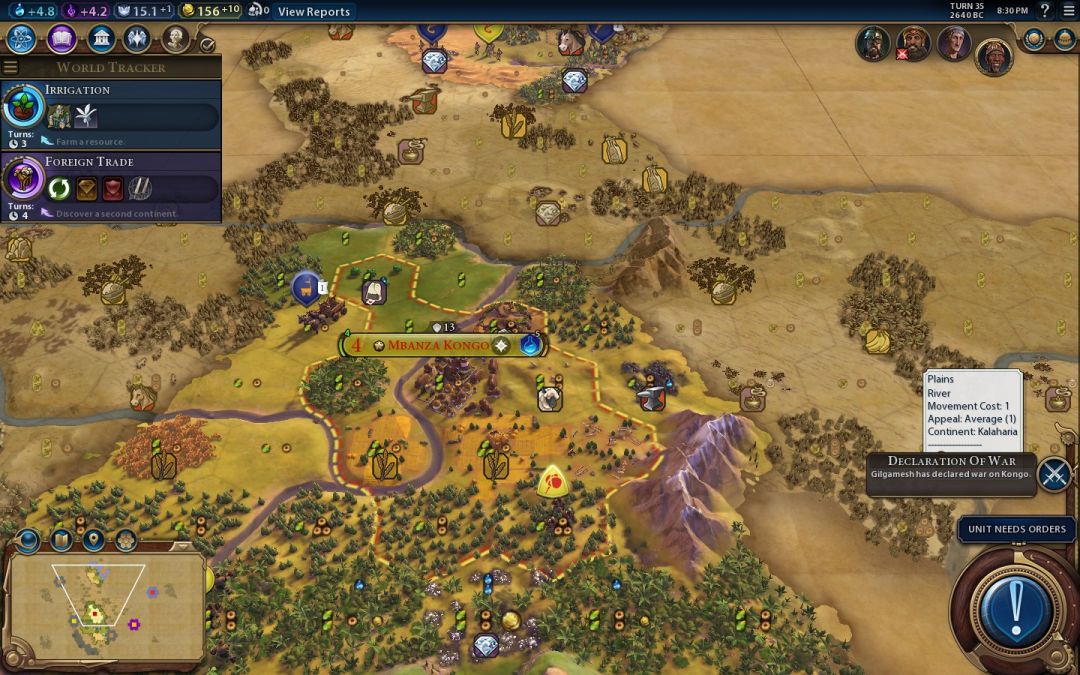
Seriously Gilgamesh, what the heck man. He decided that this large gulf of space between his core and my non-expanding capital wasn't sufficient, and declared war on Turn 35. Silly AI and their early game rushes!  I had my units out exploring, and had to pull them back to defend the Kongo. Because I had not been expecting this attack, Gilgamesh managed to catch my slinger visible at the top of the screen and kill it with one of his war carts. Two units dead in the first 35 turns! I wasn't exactly covering myself in glory here. In my defense, I hadn't expected barb horsemen to spawn in the fog at such an early date, or for Gilgamesh to try and rush me like this. Fortunately his single war cart posed no threat to end the game, and I was able to fend off this initial push without trouble. In fact, I was confident enough to finish constructing that Campus district with the aid of a forest chop before swapping over to units for defense.
I had my units out exploring, and had to pull them back to defend the Kongo. Because I had not been expecting this attack, Gilgamesh managed to catch my slinger visible at the top of the screen and kill it with one of his war carts. Two units dead in the first 35 turns! I wasn't exactly covering myself in glory here. In my defense, I hadn't expected barb horsemen to spawn in the fog at such an early date, or for Gilgamesh to try and rush me like this. Fortunately his single war cart posed no threat to end the game, and I was able to fend off this initial push without trouble. In fact, I was confident enough to finish constructing that Campus district with the aid of a forest chop before swapping over to units for defense.
50 turns into the game, this was the view inside my capital:
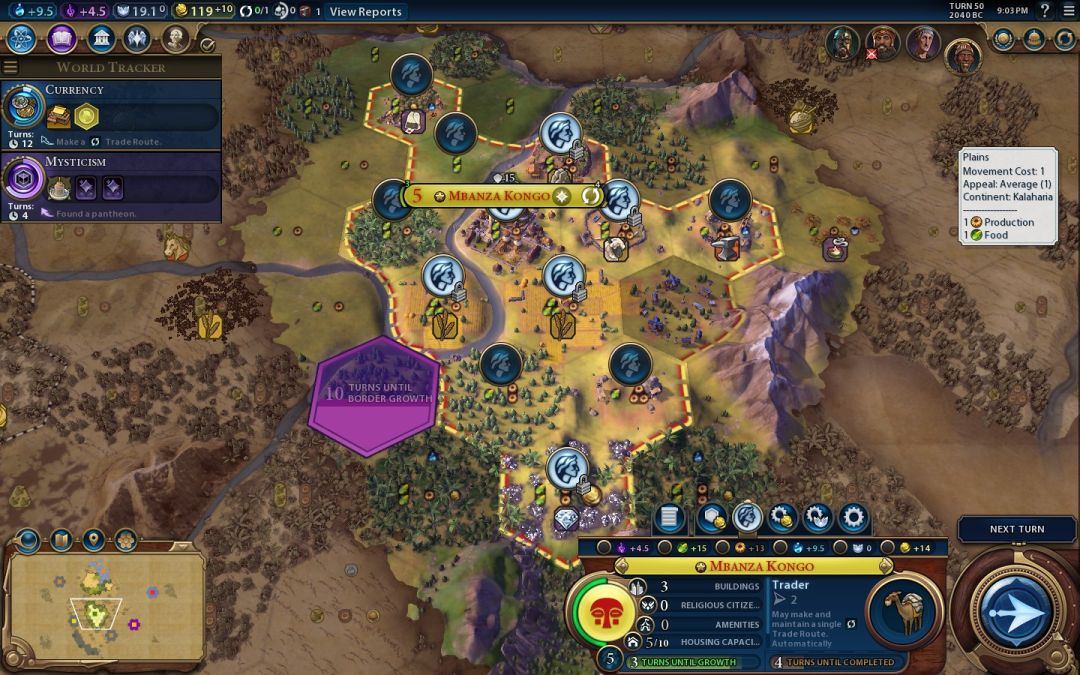
Also the view of my entire empire, for what that's worth. I am working all improved tiles with the exception of the diamonds, which had such an amazing yield that it might as well have been an improved tile. I had only recently purchased that tile and needed to squeeze out another builder to clear the jungle and mine the plains hill underneath. My first district was the Campus pictured here, going up against the mountains for the +2 adjacency bonus. There wasn't much else to debate here in terms of district choice, as I couldn't found my own religion (making a Holy Site unappealing) and an early Encampment district was even less desirable. I planned to construct the Great Library and Oxford University next to the Campus as the game went on. The city was currently working on a trader unit to boost Currency tech, and also because my gameplan does involve using trade routes to boost tourism later in the game. An early trader would not be wasted here. I sent the first trade route to one of the nearby city states to fulfill an envoy quest, and would shift the location once I had some actual tourism to boost.
In terms of wonders, I was targeting the Oracle first as a natural fit for a OCC game. Anything that boosted Great Person points in a single city would be helpful since that's all I would have in this game. I was also hoping to get Hanging Gardens as well, due to the cheap building cost and my need for vertical growth upwards in a single location. For the curious, wonders also provide tourism in Civ6: it's 2 tourism/turn as a base value for each wonder, plus another 1 tourism/turn for every era beyond the one in which the wonder is located. This makes the Ancient era wonders the most valuable ones for tourism purposes, with them eventually reaching 9 tourism/turn by the Information Age. In a normal game, wonders tend to be a fairly insignificant source of tourism when compared to all of the Great Works and artifacts available. I expected that things would be a bit different here, and I wanted to make the early wonders part of my gameplan for achieving a cultural win quickly.

Gilgamesh was willing to sign peace at this point - I was not. You think you can waltz into my territory, kill my slinger, and that I'll just sign peace the minute you want it? Fat chance buddy.  I had a warrior and three archers, which made nuisances of themselves by marching over to Sumerian territory and burning down some of Gilgamesh's tile improvements. Those ziggarats gave me free science when they were pillaged, making them a nice target indeed. I even managed to snag an unprotected builder unit (the AI really needs to do a better job of protecting their settlers/builders in this game). I had to cut off the fun pretty quickly though, as Gilgamesh had built Ancient Walls in his capital and second city, which left me with no real target to harass. Warriors and archers couldn't take too many shots from the defending cities before they were redlined, and that was the signal to sign peace and get this foolishness over with. Gilgamesh did kick in some gold in the peace treaty though, some well deserved war reparations.
I had a warrior and three archers, which made nuisances of themselves by marching over to Sumerian territory and burning down some of Gilgamesh's tile improvements. Those ziggarats gave me free science when they were pillaged, making them a nice target indeed. I even managed to snag an unprotected builder unit (the AI really needs to do a better job of protecting their settlers/builders in this game). I had to cut off the fun pretty quickly though, as Gilgamesh had built Ancient Walls in his capital and second city, which left me with no real target to harass. Warriors and archers couldn't take too many shots from the defending cities before they were redlined, and that was the signal to sign peace and get this foolishness over with. Gilgamesh did kick in some gold in the peace treaty though, some well deserved war reparations.
I finished the Oracle on Turn 64. And on the very next turn, I was able to pick my first real government at Political Philosophic civic and take:

Autocracy! This is a government that I almost never use, but which suited the circumstances of this game perfectly. Getting +1 to all yields in the capital fit this setup like a glove. I had no other cities to worry about! (Note that the bonus from Autocracy is +1 to all yields in the capital, not +1 to all tile yields. The city gets +1 food, +1 production, +1 culture, etc.) The secondary benefit was also highly useful in the form of that +10% to wonder construction. I already had my pantheon in place for +15% to wonder construction, and in the new government I would slot in the Corvee policy for another +15% to wonder construction. Then to make matters even more amusing, I became the suzerain of Industrial city-state Brussels on Turn 73, which has as its unique ability... another +15% towards wonder construction. Total bonus = 55% faster wonders.  The Hanging Gardens was roughly as expensive to build as a Commercial district with all of these policies in place. Amazing.
The Hanging Gardens was roughly as expensive to build as a Commercial district with all of these policies in place. Amazing.
The one downside to Autocracy government was the military policy slots. I had little need for anything in there, running Conscription for the 1 gold/turn savings on military units and then Discipline for the barbarian +5 strength boost for lack of anything else useful. At the same time though, what did I really need from the roster of economic policies? Not Colonization for the +50% settler production. Not Caravansaries for 2 extra gold on my one trade route, or Urban Planning for +1 production in my single city. The only economic policy that I could have used was Ilkum for the +30% faster builders, and I did swap in that card when I wasn't building wonders. I actually ran Charismatic Leader (the diplomacy +2 influence/turn card) in the wildcard slot most of the time to acquire envoys more quickly. With only one city I didn't need most of the stuff in the economic area, and the innate benefits of Autocracy proved to be more valuable.

I finished the Hanging Gardens on Turn 73 after a very fast build. I think it was 6 turns for the wonder, with me still here in the Classical era. That allowed Mbanza Kongo to slip in a 2 turn library, and then build its Theatre district, followed by its Industrial district as soon as Apprenticeship tech finished. While that was going on, I managed to accumulate enough Great Writer points to take my first Great Person, with kudos given to the Oracle's bonus effect. The Theatre district and its amphitheatre were producing 2 Great Writer points/turn, which was then doubled by the Oracle, and then doubled again by the Kongo's unique ability. Getting 8 Great Writer points/turn this early in the game with a single city was quite nice indeed, and I was able to recruit the early Great Writers in record time (for me anyway!) Those writers began stuffing their Great Works into the Palace, which started to fill up rapidly. I had Mvemba's five initial slots for the Palace, plus two more Great Writer-specific slots in the city's amphitheatre. After that, I would need to rely on wonders to provide spaces for those books, with the Great Library and Oxford University being the most desirable targets.
Turns tend to pass quickly in a One City Challenge game, which is one reason why they can be such a fun change of pace. Here was a picture of my capital on Turn 97, the same turn that the Great Library finished:

I have three districts finished along with the tier 1 building for each. For once, a Commercial district was not among the initial districts that I put down. I had already received the boost to Currency tech from building the initial trader unit, I wouldn't be able to get the later boosts for having multiple markets or banks, and the wonders enabled by the Commercial district didn't seem to be all that useful for a OCC game. I had plenty of production and relatively little need for gold. In fact, I would never end up building a Commercial district the whole game, largely because I lacked the available tiles for one with so many wonders taking up space.
Trajan had been kind enough to spread his Buddhist faith into my capital, which had the extremely convenient Divine Inspiration belief: all world wonders produce +4 faith. Thanks man! Then later on the other AI civs would send their own missionaries to Mbanza Kongo and knock me out of Buddhism - argh! One thing I wondered after this game ended was whether I should have built a Holy Site and targeted some of the early wonders that it unlocks. I couldn't found my own religion, but Buddhism would have been pretty useful to keep, and there are a lot of early game wonders associated with religion. That said, I'm not sure that I had enough room for another district and additional wonders. It's something I'll have to consider if I do another one of these games.
I was also starting to produce some legitimate tourism by this point, so let's discuss the mechanics of a cultural victory in a bit more detail. Feel to skip over this next part if you're not interested in the mechanics discussion.
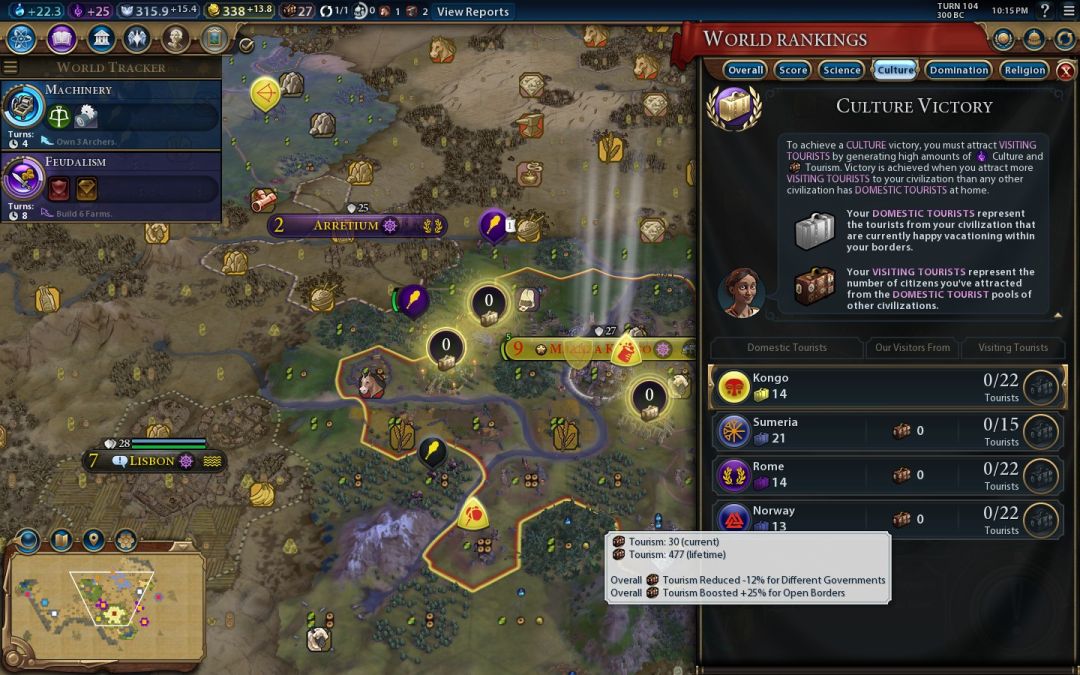
This is the cultural victory screen familiar to anyone who's played Civ6. When I played my initial Adventure One game, I had no idea what any of these numbers meant or how the tourism meter on the right hand side filled up. The interface itself has not changed, and the appalling lack of documentation about what's really taking place here is something that needs to be corrected for the future. Firaxis, there's no excuse for failing to explain what these numbers mean with tooltip help or additional documentation in the Civilopedia!  I discovered how the system works through an excellent guide written by poster Victoria at CivFanatics. I will attempt to summarize the key findings of that much longer guide here.
I discovered how the system works through an excellent guide written by poster Victoria at CivFanatics. I will attempt to summarize the key findings of that much longer guide here.
Let's start with domestic tourism, the number on the left side of the screen with the little colored suitcases. Domestic tourism is how you DEFEND against a cultural victory in Civ6, and it has nothing to do with the tourism number on the bar at the top of the screen whatsoever. The short version of the calculation is this: for every 100 culture that your civilization produces, you gain one domestic tourist. Inspirations (the cultural boosts) count towards this number as though you had actually produced that culture. As a result, my civ had produced approximately 1400 culture at this point over the course of the whole game, which feels about right. By mousing over this number, you can see the current cultural output of each civ. Divide that number by 100 to estimate the rate at which that civ will be adding domestic tourists. If a civ is producing 50 culture each turn, they will add a domestic tourist every other turn.
The number in the middle with the brown suitcase is the foreign tourist figure. This is the number that you must increase in order to win a cultural victory; foreign tourism is the OFFENSIVE component of a cultural victory. The interface is particularly lacking here, as it does not explain at all how this number is connected to the tourism number at the top of the screen. The important number isn't really the per turn tourism listed at the top of the screen, but the LIFETIME tourism accumulated with each other civilization on the map. This is where foreign tourists come from, and the formula is 1 foreign tourist for every (150 * Number of Civs in game) lifetime tourism with that civ. On a Tiny map here with 4 civs, that was 1 foreign tourist for every 150 * 4 = 600 lifetime tourism. (On a Standard map with 8 total civs, it's 1 tourist for every 1200 lifetime tourism.) Each turn, the base tourism number at the top of the screen is fed through modifiers to get the actual tourism amount going to other civs. In the picture here, my base 27 tourism gets multiplied by -12% for different governments and +25% for having open borders, resulting in a total tourism modifier to Norway of +13% and a total tourism output of 30/turn. When this lifetime number reaches 600 tourism, I will gain one foreign tourist from Scandinavia. The same calculation applies to every other civ with which you have contact. At my current rate of roughly 30 tourism/turn with each of the three AI civs, I'm getting about 90 total tourism per turn; divided out of 600 tourism required per foreign tourist, I will gain one about every 6-7 turns.
A cultural victory occurs when the the winner has more foreign tourists than anyone else has domestic tourists; this is the infamous meter on the right side of the screen. Note that the offensive and defensive components of the cultural victory have nothing in common with each other at all. Amassing tourism does not prevent another civ from winning a cultural victory themselves, and culture itself does nothing directly to help you win via tourism. Long story short: culture = defense, tourism = offense. If you want to win via culture, then you want to stop other civs from getting culture, which will help them defend against your tourism onslaught. It doesn't really matter if they start producing tourism themselves. Note as well that the per-turn modifiers to tourism are extremely important. Open Borders is worth a 25% bonus and therefore the player should be running Open Borders at all times with everyone else when pursuing a cultural win. A trade route is worth another 25% bonus, and there's a lategame civic that can increase that bonus to 75%. We saw this difference firsthand in our Commercial Free Programming succession game, where a combination of Open Borders and trade routes accelerated our game past even the Brazilian AI's impressive cultural showing. I wouldn't need anywhere near that much tourism to win in this game, but then again, I only had a single city to work with!

Here's another look inside the city to see the tiles that it was working, along with the total production output. I had been slowly shifting the farming region of my civ over to the west, largely because I had been forced to place wonders and districts on top of some of the tiles that I had previously been working. There was a group of poor wheat farmers who had been rudely displaced by the Great Library, for example. Otherwise it was mostly mines and resources that I was working, enough to add up to a total output of 26 production from worked tiles. Along with the Industrial district and alliances with the two nearby Industrial city states, I was building things very fast indeed. The Colosseum was a 7 turn build, for example, boosted by all those wonder construction policies. The limitation here was tiles to put the wonders on top of, and fulfilling the various requirements to construct them, not the wonder construction itself.
A word about the Colosseum. I had built an Entertainment district north of the city to enable the wonder, thinking that it would solve any happiness issues that I might have in this game. I was worried that I would run into unhappiness with a very tall city compared to my normal setup. This proved to be a non-issue though, largely because my city state alliance with Buenos Aires caused all my bonus resources to behave like luxuries, and even though I only had 1 copy of each, that was all I needed with one city. As a result, Mbanza Kongo would later climb as high as +10 (!) on the amenities screen, which is a number I never expect to see again. It didn't do anything more than +1 amenities though, as all happiness levels above zero appear to be identical. In retrospect, I think it would have been better to produce a Holy Site district and target some of the religious wonders associated with the district. Most of them are located in the Ancient or Classical age and would have been worth a lot of era-based tourism as the game went on. The Entertainment district + Colosseum pairing was two tiles that could have been better used elsewhere. (I wanted to build the Pyramids really badly and could not due to having no desert tiles available. Obviously this ruled out Petra as well.)
My research in the above screenshot was towards Printing, which has the secondary property of doubling tourism from Great Works of Writing. I was pulling in Great Writers left and right, which would make that bonus extremely helpful. The inability to get the boost (from building two universities) was a bit sad though. When I finished the tech on Turn 125, my tourism effectively doubled overnight, going up to 66 base tourism/turn:

After being fed through modifiers, that was 91 tourism/turn with Sumeria. I had my one trade route going to Gilgamesh, as he had the most culture and therefore the most domestic tourism. The math at this point worked out to 91 tourism/turn with Sumeria and about 75 tourism/turn with Rome and Scandinavia (since I could not send them a trade route yet). At a total of roughly 240 tourism/turn, I would get a new foreign tourist every 2.5 turns. With Gilgamesh adding a new domestic tourist roughly every 3 turns, I was making very slow incremental progress towards the victory. Obviously I was going to need more tourism than this though, if I wanted to finish before the 21st century anyway.
The turns continued to pass by quickly. I was running some odd policies here, with no need for normal things like the trade route gold bonus. Instead I was mostly trying to get additional science and culture to advance into new techs/civics more quickly, running both the Campus and Theatre district adjacency boosting policies. I was even running the +2 Great Writer points policy in the Wildcard slot, which is normally one of the weakest options but actually useful here. Gilgamesh AI was ineffectually ramming a series of horsemen into the walls of the Buenos Aires city state, and otherwise things were quiet.
I was getting a lot of Great Writers. A lot of them:
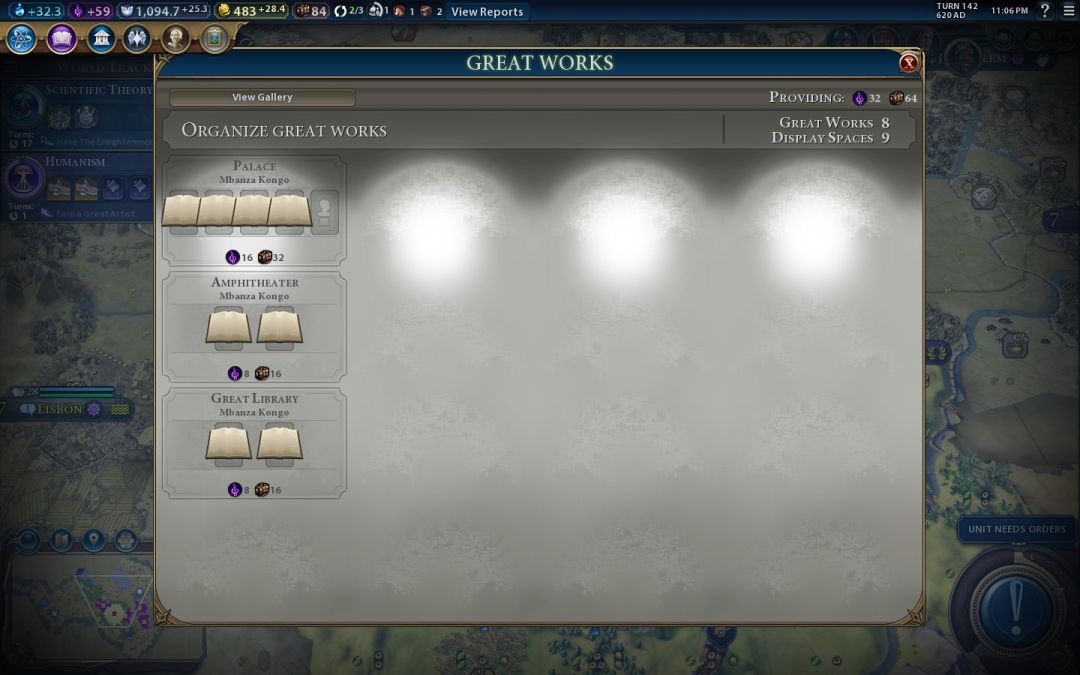
Mbanza Kongo: the city that reads!  Here's the real problem with a One City Challenge cultural game: lack of slots for Great Works. I heavily dislike this aspect of the cultural victory while enjoying it in most other ways. I think it's ridiculous and silly to require "slots" to place the various Great Works. The challenge is recruiting the Great Artist, not finding a place to put the paintings after recruiting the individual. That's the kind of thing that should be abstracted; after all, the game doesn't require the player to manage the goods on sale in the markets, or resolve labor disputs amongst the factory workers. What is fun or interesting about having to manage the art slots for books and paintings and music? It's especially dumb when players manage to recruit Great People before they are "supposed" to recruit them, like when Russia has a bunch of Great Musicians that literally can't use their Great Works for lack of places to put them. This is frustrating and silly.
Here's the real problem with a One City Challenge cultural game: lack of slots for Great Works. I heavily dislike this aspect of the cultural victory while enjoying it in most other ways. I think it's ridiculous and silly to require "slots" to place the various Great Works. The challenge is recruiting the Great Artist, not finding a place to put the paintings after recruiting the individual. That's the kind of thing that should be abstracted; after all, the game doesn't require the player to manage the goods on sale in the markets, or resolve labor disputs amongst the factory workers. What is fun or interesting about having to manage the art slots for books and paintings and music? It's especially dumb when players manage to recruit Great People before they are "supposed" to recruit them, like when Russia has a bunch of Great Musicians that literally can't use their Great Works for lack of places to put them. This is frustrating and silly.
For a OCC setup, the player quickly begins running up against these limits. If I weren't playing as the Kongo in this game, I wouldn't have the 5 slots for the Palace, and most of the Great Writers would be going to waste. And yes, I know that the cultural victory isn't supposed to be played out of a single city, but that's not really the point. There's nothing of strategic interest in constructing the various buildings for the Great Works; it's just tedious micromanagement and busywork for the sake of busywork. In the context of this particular game, it would put me under the clock. I needed to win fairly quickly, as I would eventually hit a point at which I could not place any more Great Works into these slots, and could not put additional wonders down on the map due to lack of room. My tourism output would then cease to increase, while the domestic culture output of my AI rivals would continue to go up. This was the tension in my game, and it was largely due to these very silly placement rules for the Great Works.
I thought that the rest of the game would be uneventful, then this happened:
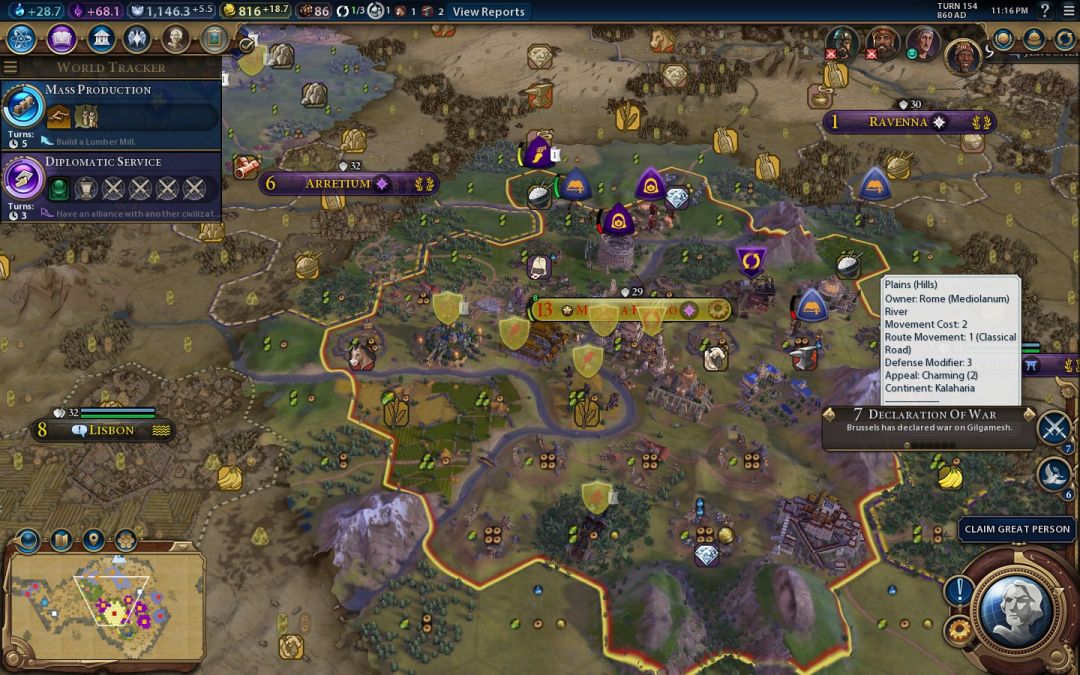
Joint war declaration from Gilgamesh and Harald.  What did I ever due to you guys? Well OK, I did pillage the territory around the Sumerian capital back in the day, but that was a war that Gilgamesh started too. Fortunately this wasn't as dangerous as it might appear; neither AI leader had units near my territory, and Harald in particular was a long way away. Gilgamesh seemed more interested in continuing to attack Buenos Aires over and over again (which was my city state ally) than chasing after me. I had an archer in that area, just visible in the top left corner of the screenshot, which I had posted to make sure that Buenos Aires wouldn't actually be conquered. Somehow that archer managed to survive and make it home despite a whole bunch of Sumerian horsemen in the vicinity. The AI isn't very good at this One Unit Per Tile thing... I swapped into Professional Army policy for the discounted upgrades, turned my archers into crossbows and my warriors into Ngao Mbebas (the unique unit sword replacement), and that removed any danger. I signed peace as soon as possible with both of the AIs so that I could reestablish Open Borders and trade routes for the tourism bonuses. You guys are supposed to go vacationing in the Kongo, not attack it!
What did I ever due to you guys? Well OK, I did pillage the territory around the Sumerian capital back in the day, but that was a war that Gilgamesh started too. Fortunately this wasn't as dangerous as it might appear; neither AI leader had units near my territory, and Harald in particular was a long way away. Gilgamesh seemed more interested in continuing to attack Buenos Aires over and over again (which was my city state ally) than chasing after me. I had an archer in that area, just visible in the top left corner of the screenshot, which I had posted to make sure that Buenos Aires wouldn't actually be conquered. Somehow that archer managed to survive and make it home despite a whole bunch of Sumerian horsemen in the vicinity. The AI isn't very good at this One Unit Per Tile thing... I swapped into Professional Army policy for the discounted upgrades, turned my archers into crossbows and my warriors into Ngao Mbebas (the unique unit sword replacement), and that removed any danger. I signed peace as soon as possible with both of the AIs so that I could reestablish Open Borders and trade routes for the tourism bonuses. You guys are supposed to go vacationing in the Kongo, not attack it!

My capital a little bit later, after that silly war was over and things had settled down. I had just cracked the 100 (base) tourism/turn mark and was about to finish Bolshoi Theatre, one of the more useful wonders for a cultural victory since it would provide a few more slots for Great Works. I had also constructed the Forbidden City and Potala Palace for lots of policy card slots; for once, I had more available options than I really needed. I also built Chichen Itza solely for the wonder tourism, not for the actual rainforest benefit. Bet you won't hear that too often! I had already chopped down all but a single rainforest tile, and that would be getting Ruhr Valley shortly. I did build one Mbanza, the unique Neighborhood district for Kongo, which took the capital up to a housing capacity of 20. There was no need to go any further from there, as I wouldn't have any place for the extra citizens to go (beyond specialist slots, I guess, which aren't very strong in Civ6). I had enough population to build more districts, and I would have liked an Encampment to open up a few more wonders, however I lacked the tiles to place one! Perhaps I should have replaced the farms to the southwest of the city itself; in restrospect, that likely would have been the better move. I had additional food coming in from non-map sources by now:

Like these sculptures from another one of Kongo's unique abilities (Nkisi). The six food coming from these works of art could have replaced two of those farms. Ah well, lessons for the next game. Anyway, I had opted to go with an art museum over an archaeology museum, largely because I had the Great Artist available and it would take significantly longer to research my way to the archaeologist unit, build one, and then dig up the artifacts themselves. I figured it was better to get the benefit from the sculptures in play 20 turns sooner, even if they would be worth slightly less than artifacts in the long run. I still don't know if this was the right decision. By the way, note that 84 tourism was coming from the various Great Works on this screen... which meant that 34 tourism was coming from the wonders themselves (28%). While you can't win a cultural victory off of wonder tourism alone (barring something very strange), it definitely contributes to the overall total.
There was one amusing diplomatic interaction during these turns:

Trajan kept sending me this message! Oh no, my SINGLE CITY, where my settler never moved from the starting tile, was "so close" to his territory. I wasn't the one who had been foolish enough to plant little filler cities right on the border of a cultural giant. And he was also "nervous" of the Kongolese miilitary that was "so strong"? I don't think this fellow was quite right in the head. 
I would go on to build Ruhr Valley and then the Hermitage in my city, which essentially finished off the available tiles for building. I was largely stuck now with the wonders that I already had. The slots for Great Works were now all full, and additional Great People had nothing to do, the new ones standing around in my territory like Depression-era workers on the dole. Mbanza Kongo largely occupied itself with building Campus Research grants:

For once, I was going after these projects for the beaker bonus, not the Great People points. I was doing pretty well on culture for researching new civics, but I was struggling on the research front to unlock new technologies. In particular, I was hampered by my lack of Oxford University. Yes, it's true: I was never able to build the wonder, which would have been perfect for my setup. Not only does Oxford grant the two free technologies, it would also provide 20% additional science in my sole city, and open up two more desperately-needed slots for Great Works of Writing. How could my planning have been poor enough to miss this wonder? Blame the lying documentation in the Civilopedia. The entry for the Great Library states that the wonder must be "on a flatground plains or grassland tile next to a Campus district". OK fair enough, and I had put it on the one tile that qualified. For Oxford University, the Civilopedia states it must be "on plains or grassland next to a Campus district". I assumed that hill tiles would work just fine, since the Great Library had very specifically said that it required flat terrain, while Oxford said nothing of the sort. Nope, it turns out that they both require flatground. Oxford University can't be built on hills. Thanks Civilopedia. Why is the documentation for everything so poor in this game? 
That meant that my science stalled out around 60 beakers/turn, not a very impressive amount. With the Campus Research Grants project running, that number would jump up into the 70-80 beaker/turn range. It tended to jump around from turn to turn, which didn't make much sense to me. How exactly does this project produce extra beakers anyway (?) I also wasn't helped by being unable to complete so many of the tech boosts, including all of the ones related to naval stuff. The key tech I wanted was Computers because it doubles all sources of tourism. I was very slowly limping there at my best research rate, each tech taking 15 or more turns. I really could have used Oxford here.
Yet as it turned out, with trade routes and Open Borders running towards all AI civs, even a little over 100 tourism was enough to make huge strides towards winning a cultural victory:
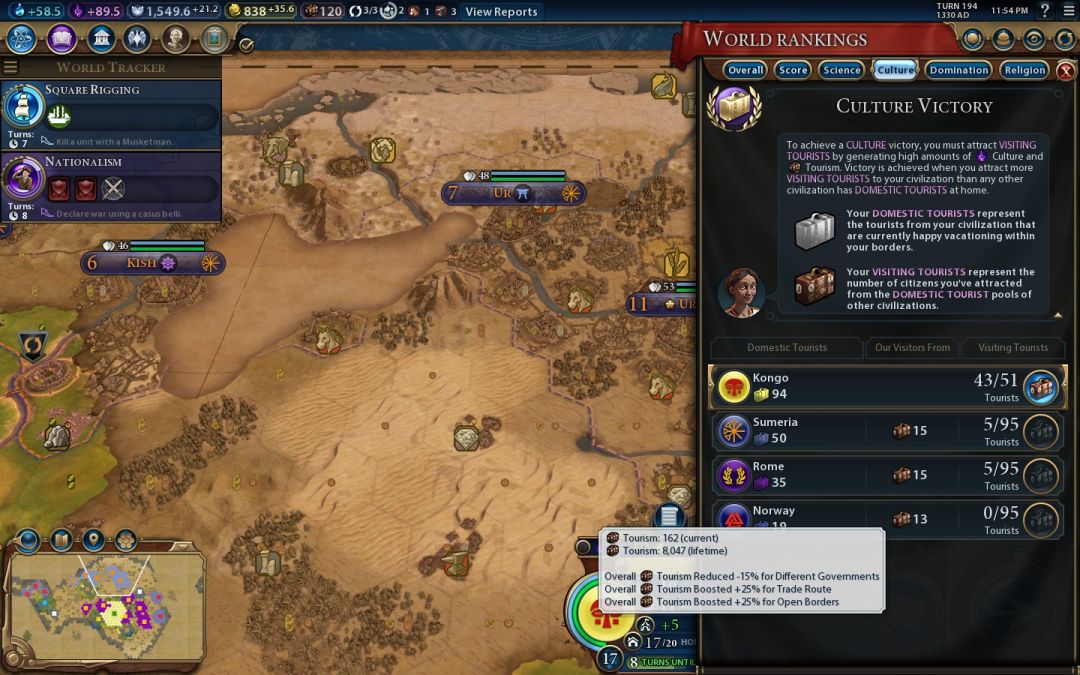
Open Borders together with a trade route provides a 50% bonus towards tourism with that civilization. It had been easy to get a trade route to Sumeria and Rome from the start, and I ran routes to both of them as soon as I reached Merchant Republic government. Scandinavia was tougher because my trade route capacity didn't reach that far, even though I had a trade post in the city of Rome that should have reached Nidaros. I ended up sending a trade route to the city state of Jerusalem, and when that wore off, the trade post in the city state gave me enough range to reach the Vikings. The result was the numbers that you see here.
After modifiers, I was producing 162 tourism/turn with Scandinavia. I was getting slightly more tourism with Sumeria and Rome, as both of them were also in a Merchant Republic and lacked a "different governments" penalty. At 180 tourism for both of them, plus the 162 tourism with Harald, that was a total figure of 180 + 180 + 162 = 522 tourism/turn. I would get a foreign tourist for every 600 tourism, which meant a new foriegn tourist almost every turn (522 / 600 = 0.87 tourists per turn). On the other side of the cultural equation, Sumeria had barely increased their culture at all, and Gilgamesh was producing right around 33 culture/turn. (You can see this number by mousing over the civ's logo on the left side of the interface.) Since the game produces a domestic tourist for every 100 culture, Gilgamesh was adding about 0.33 domestic tourists per turn. I was clearly making progress in this regard, gaining foreign tourists faster than Gilgamesh could produce domestic ones to defend himself. As long the current pace continued, I would win in time.
And... essentially that's what happened. I hit 64/64 tourists required on Turn 217, and won a cultural victory at the end of the turn. Not the most compelling result from a storytelling aspect, but hey, they can't all be nailbiters. This one was nice and routine. Here was the final Great Works screen:
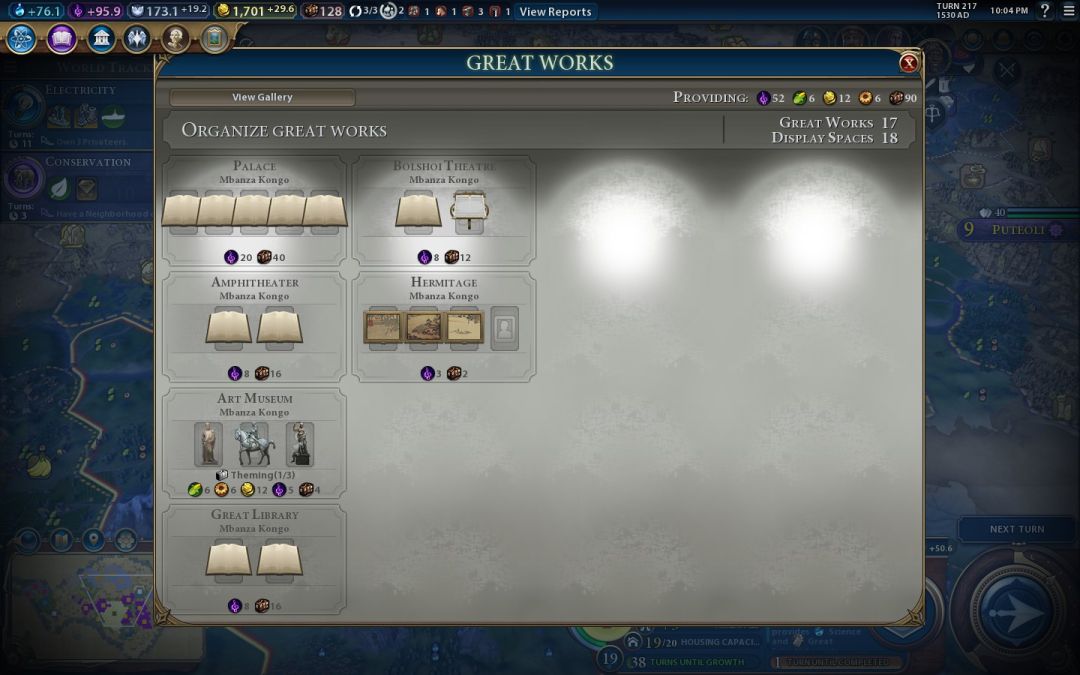
I had all but a single art slot filled, and a poor Great Writer and Great Musician waiting fruitlessly outside the capital waiting for something to do. If I had managed to build Oxford University as planned, this would have been almost perfectly lined up from a Great Works perspective. The Great Works of Writing were by far the biggest driver of tourism, since their output had been doubled at Printing tech and I hadn't reached the various techs/civics later on the tree to boost the Great Works of Art or Music. The sheer number of the Great Works of Writing was also impressive, as I had ten of them here and another unusued Great Writer beyond that. Six total Great Writers! That leads to another helpful post-game screenshot:
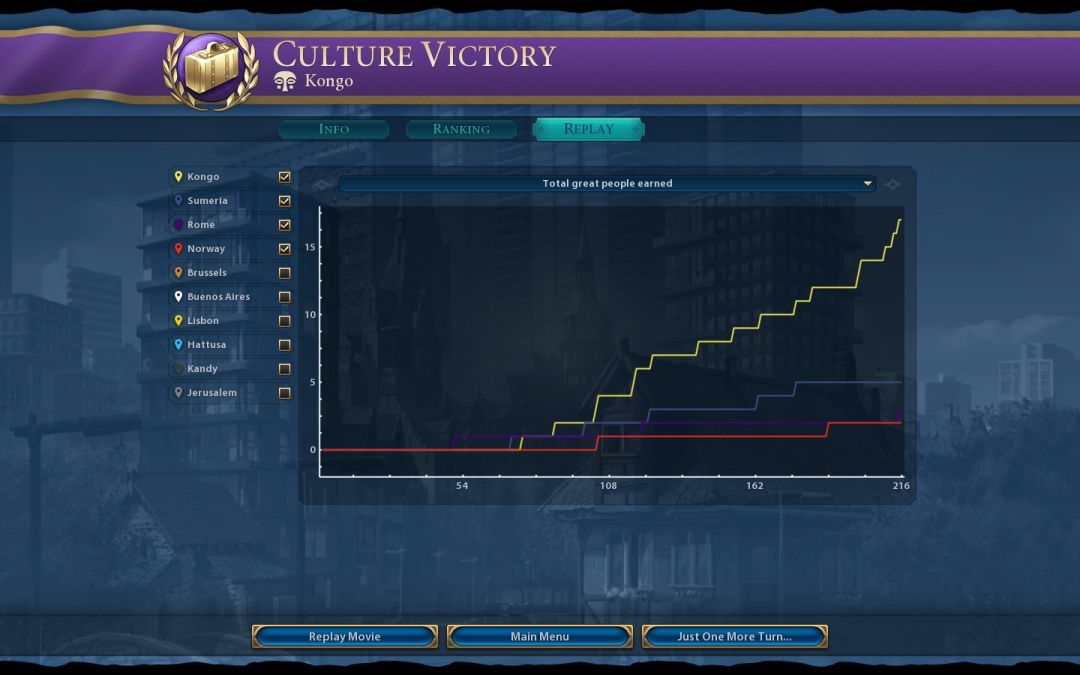
This bar graph tracks the total number of Great People earned over the course of the game. I crushed the AI civs in this department, even with the very limited districts that I was able to build. The total Great Person score was Norway = 2, Rome = 3, Sumeria = 5, and Kongo = 17. Keep in mind, that included the three Great Prophets produced in this game, one for each AI civ, several Great Merchants, and a Great Admiral. None of them had any impact on a cultural victory. Rome claimed a Great Writer at the very end of the game, and that was it. I recruited every other Great Person related to culture, and aside from that very late Great Writer, I claimed all of the Great Works for the whole game. This was the key to winning a fast cultural victory: I denied the AI civs all of the Great Works, which kept their domestic culture down and made it easier to emerge victorious despite a rather unimpressive tourism output myself.
This was a fun little game to play. It only took a couple of hours and had me thinking a lot about city planning and how to best leverage the cultural victory mechanics. I don't think Civ6 is very well suited to OCC setups, which is why I wanted to play at least one of them and experiment with how it went. I think that OCC culture is doable on a higher difficulty level, as I would have been able to pull in some of the lategame techs/civics to boost the base tourism number up to around 300/turn, and that likely would have been enough in most settings. That said, the larger the map and the more AI civs in the game, the harder it will be to win this way. I was glad to run this on a Tiny map where I could send trade routes to all three of the AI opponents.
I hope you enjoyed this short report. Thanks for reading. 



